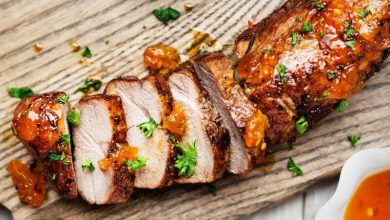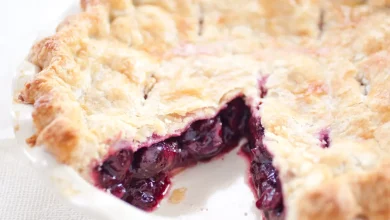All-American Pancakes are a beloved breakfast classic in the United States, known for their fluffy texture and sweet, comforting taste. They are typically served stacked high, drizzled with maple syrup, and often accompanied by butter, fruit, or other toppings. Here’s a detailed overview of their history, components, preparation steps, and the time needed to prepare them:
History:
Pancakes, in various forms, have been a part of human cuisine for centuries, with a history that predates written records. The modern American pancake, as we know it today, evolved from European and Native American culinary traditions. Early European settlers in North America adapted their pancake recipes using ingredients available in the New World, such as cornmeal and buckwheat.
The term “pancake” itself comes from the pan-fried method of cooking these batter-based cakes. Over time, pancakes became a popular breakfast staple in the United States and have been enjoyed in countless variations.
Components:
The basic components of All-American Pancakes include:
-
Pancake Batter: This typically consists of flour, sugar, baking powder, eggs, milk, a pinch of salt, and melted butter. Some recipes may also include vanilla extract for added flavor.
-
Toppings: All-American Pancakes are often served with a variety of toppings, which can include:
- Maple Syrup: A classic choice, maple syrup adds sweetness and a delightful flavor.
- Butter: A pat of butter on top of the hot pancakes melts and adds richness.
- Fruit: Sliced bananas, strawberries, blueberries, or other fruits provide freshness and color.
- Whipped Cream: For a decadent touch.
- Nuts: Chopped nuts like walnuts or pecans can add a satisfying crunch.
- Chocolate Chips: A sweet indulgence for those who love chocolate.
Steps to Prepare All-American Pancakes:
Here’s a step-by-step guide to making delicious All-American Pancakes:
Ingredients:
- 1 cup all-purpose flour
- 2 tablespoons granulated sugar
- 1 teaspoon baking powder
- 1/2 teaspoon salt
- 1 cup milk
- 1 large egg
- 2 tablespoons melted butter
- 1 teaspoon vanilla extract (optional)
- Cooking spray or additional melted butter for the pan
Instructions:
-
Preheat the Griddle or Pan: Place a griddle or a non-stick skillet over medium heat and allow it to heat up. You can test if it’s hot enough by sprinkling a few drops of water on the surface. If they sizzle and evaporate, it’s ready.
-
Prepare the Dry Ingredients: In a large mixing bowl, whisk together the flour, sugar, baking powder, and salt.
-
Prepare the Wet Ingredients: In another bowl, whisk the milk, egg, melted butter, and vanilla extract (if using).
-
Combine Dry and Wet Ingredients: Pour the wet ingredients into the dry ingredients and stir until just combined. Be careful not to overmix; a few lumps in the batter are okay.
-
Cook the Pancakes: Lightly grease the griddle or skillet with cooking spray or melted butter. Ladle a portion of the pancake batter onto the hot surface to form pancakes of your desired size. Cook until you see bubbles forming on the surface, then flip and cook until the other side is golden brown.
-
Serve: Stack the pancakes on a plate, add your desired toppings, and serve hot.
Preparation Time:
The time needed to prepare All-American Pancakes will vary depending on factors such as your cooking skill and the number of pancakes you’re making. On average, it takes about 15-20 minutes to prepare a batch of pancakes that serves 2-4 people. This time includes both preparation and cooking.
In summary, All-American Pancakes are a beloved breakfast dish with a rich history, consisting of a simple batter cooked on a griddle and served with a variety of toppings. With the right ingredients and a little practice, you can whip up a delicious stack of pancakes in no time, making them a perfect treat for breakfast or brunch. Enjoy!
Certainly, here’s some nutrition and health information for All-American Pancakes:
Nutrition Facts (per serving, without toppings, approximate):
- Calories: 150-200 calories
- Carbohydrates: 20-30 grams
- Protein: 4-6 grams
- Fat: 5-8 grams
- Fiber: 1-2 grams
- Sugar: 3-6 grams
- Sodium: 300-400 milligrams
Health Information:
-
Caloric Content: All-American Pancakes can be moderate in calories. The calorie content can vary based on the size and ingredients used. While they can fit into a balanced diet, it’s important to be mindful of portion size and added toppings.
-
Carbohydrates: Pancakes are primarily composed of carbohydrates from flour and sugar. Carbohydrates provide energy but should be consumed in moderation, especially if you have specific dietary requirements.
-
Protein: Pancakes contain a moderate amount of protein, but they are not a significant source. To boost protein intake, consider adding ingredients like Greek yogurt or nuts to the batter.
-
Fat: The fat content in pancakes comes from ingredients like butter and milk. While fat is essential for flavor and texture, it’s advisable to use them in moderation to keep the dish balanced.
-
Fiber: Pancakes typically contain minimal fiber. To increase fiber content, consider using whole wheat flour or adding ground flaxseeds to the batter.
-
Sugar: Pancakes often contain added sugar, both in the batter and as toppings. Excessive sugar intake should be limited to maintain overall health.
-
Sodium: Pancakes can contain sodium, mainly from baking powder and any added salt. Be mindful of sodium intake, especially if you have hypertension or are watching your salt intake.
Health Tips:
- To make pancakes healthier, consider using whole wheat flour or oat flour instead of all-purpose flour for added fiber.
- Use natural sweeteners like honey or fresh fruit as toppings instead of excessive amounts of syrup or powdered sugar.
- Add sliced bananas, blueberries, or other fruits to increase the nutritional value and add natural sweetness.
- Opt for lower-fat dairy products and use them sparingly in the batter.
- Cook pancakes with a non-stick pan or griddle to reduce the need for excess butter or oil.
While All-American Pancakes can be enjoyed as an occasional treat, it’s essential to balance them with a diet rich in fruits, vegetables, lean proteins, and whole grains for overall health and nutrition.




